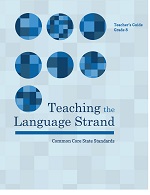Cherry Picking the Common Core
One of our more flexible idiomatic expressions in English is “cherry picking.” Cherry picking can mean picking the easiest fruit on the tree or picking the best fruit on the tree, or picking just the fruit on the tree that we want and ignoring the rest.
The latter use of “cherry picking” would seem to apply to many districts and teachers as they have begun implementing the Common Core Standards. To get a bit technical, many have bought into the fallacy of selective attention, known as confirmation bias.
As elementary and middle-high school English-language Arts teachers began unraveling the Common Core State Standards for English Language Arts & Literacy in History/Social Studies, Science, and Technical Subjects in 2011, they tended to gravitate to the Reading: Literature, Reading: Informational Text, and Writing Strands.
Although some decried the “loss” of literature with the new focus on expository reading text, most began interpreting the Standards as “basically teaching what they already teach” with a few added tweaks. In my school district the mantra at all district Common Core trainings has been “Common Core-ize it!” In other words, keep on doing what we have been doing, but add on a few close reading strategies and some expository text and “You’re good to go!”
It’s human nature. We interpret new sensory input in light of previously acquired sensory input. Cherry picking.
Now, some of this Standards-cherry-picking does make sense. Now let me mix my food metaphors a bit. Obviously, reading (the meat) and writing (the potatoes) remain the cornerstones of literacy and should be instructional priorities. Additionally, there is some practical rationale to not introducing everything at once, so stair-stepping in the Standards would seem to be a prudent approach. However, we are in year four of implementation of the Common Core State Standards. The full dinner includes more than just meat and potatoes.
The cherries many have been avoiding would include the Language Strand and Speaking and Listening Strand. Scant attention has been paid to either of these Strands. I’ve asked countless district curriculum specialists and teachers whether they have read either of the Strands, and if they have, could they name one of the Standards in that Strand, and if they can, have they implemented any of the Standards in their district trainings or in their classrooms. You know their answers.
It’s time to set the table with a well-balanced meal.
Teachers are ready. Teachers can chew gum and walk at the same time. Teachers can implement the Common Core State Standards for English Language Arts & Literacy in History/Social Studies, Science, and Technical Subjects as they are designed–each part working to better the whole. I just googled “Common Core Reading Standards” and got 42,500,000 (not surprising) search results. “Common Core Writing Standards” got 27,200,00 (not surprising) search results. But these search results did surprise me: “Common Core Language Standards” got 40,600,000 results. Obviously there is significant interest in moving beyond the implementation of just the reading and writing Standards.
Now of course I am biased as well. As an educational publisher, I’m selling curriculum to address these up to this point ignored Standards. So, you would expect my own cherry picking. But I also feel that our students deserve a well-balanced diet. They need the full meal–not just the meat and potatoes. My take is that a diet of meat and potatoes can only take our students so far. Students also need the grammar, usage, mechanics, spelling, vocabulary, speaking, and listening knowledge and skills to inform and equip them in their reading and writing.
And how about cherries jubilee for dessert?
The author of this article, Mark Pennington, has written the assessment-based Grammar, Mechanics, Spelling, and Vocabulary Grades 4-8 programs to teach the Common Core Language Standards. Each full-year program provides 56 interactive grammar, usage, and mechanics lessons. (Check out a seventh grade teacher teaching the direct instruction and practice components of these lessons on YouTube.) The complete lessons also include sentence diagrams, error analysis, mentor texts, writing applications, and sentence dictation formative assessments with accompanying worksheets (L.1, 2). Plus, each grade-level program has weekly spelling pattern tests and accompanying spelling sort worksheets (L.2), 56 language application opener worksheets (L.3), and 56 vocabulary worksheets with multiple-meaning words, Greek and Latin word parts, figures of speech, word relationships with context clue practice, connotations, and four square academic language practice (L.4, 5, and 6). Comprehensive biweekly unit tests measure recognition, understanding, and application of all language components.
